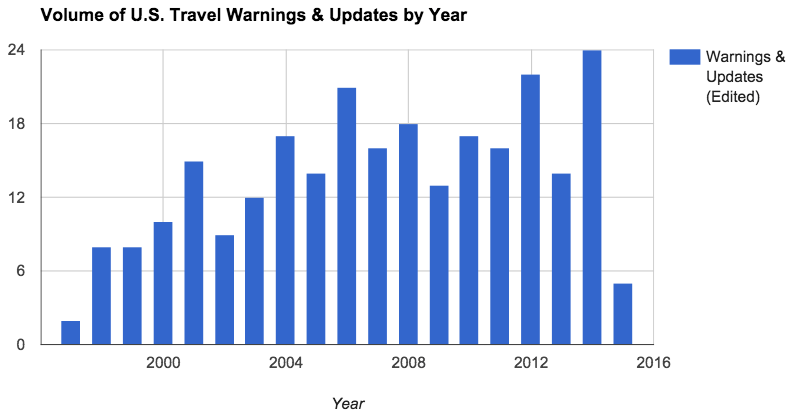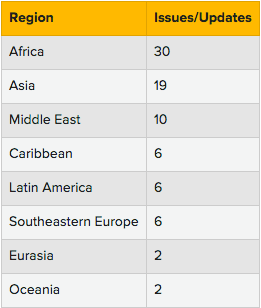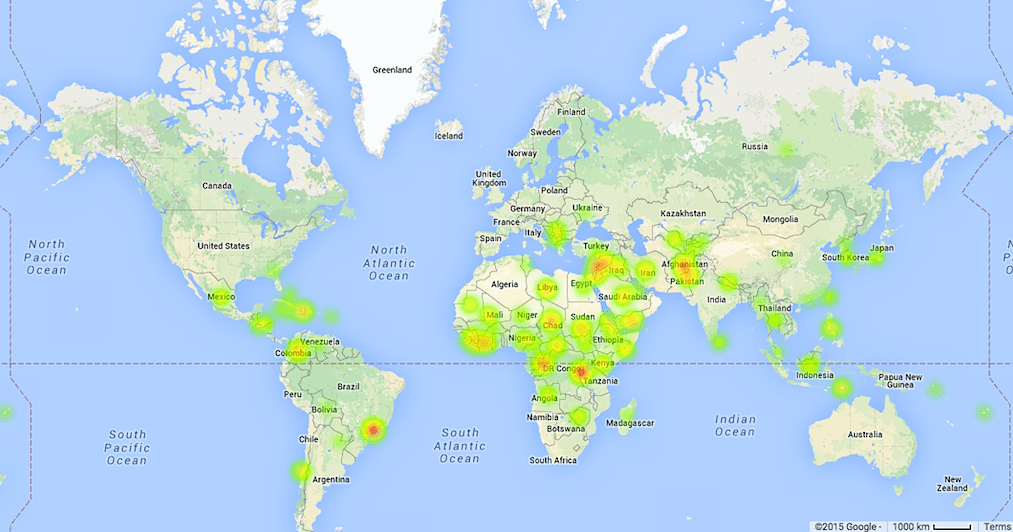Skift Take
Travel warnings signal areas with long-term chronic concerns for U.S. citizens so they're less about informing travelers and more about maintaining status updates on already controversial areas.
In the first four months of 2015, the U.S. State Department has already issued updates to travel warnings for 18 countries.
Nigeria, Honduras, and Yemen were a few of the countries in which changing conditions prompted an update this year. Updates are frequent occurrences with the a mixture of field officers and government agencies informing the department’s Bureau of Consular affairs.
Although travel warnings don’t necessarily mean U.S. citizens can not visit a destination, it does signify long-term circumstances which are not ideal to vacations or even business travel.
Skift recently looked back at 18 years of travel warnings and updates to get a better idea of where and when travel warnings are most common. Our data set starts in 1996 because that is when data first came online.
There were 896 travel warnings issued or updated since 1996.
Travel warnings are only issued once and then remain valid indefinitely until they are officially cancelled or revised. The majority of these publications then are updates to existing travel warnings. We only counted updates that were separated by at least one month.

Once we removed updates from within the same month, we found 261 travel warnings issued or updated for 80 countries since 1996.
“A Travel Warning is issued when the State Department views the threat to U.S. citizens in a specific country to be chronic and long-term,” says a spokesperson for the State Department’s Bureau of Consular Affairs.
“Travel Warnings may be issued in response to civil unrest, dangerous conditions, terrorist activity and/or because the United States has no diplomatic relations with the country and cannot assist a U.S. citizen in distress.”
The volume of travel warnings issued and updated grew steadily from 1997 until 2006. It dropped slightly again before reaching an 18-year record in 2014.
The growth of warnings and updates remains relatively the same even when the data is unedited and includes multiple updates in a single month.
Travel warnings were only lifted or cancelled for 17 countries in that time.
Travel warnings were issued or updated the most often in Africa (30) followed by Asia (19) and the Middle East (10).

There were no travel warnings issued or updated for North America or Europe — outside of southeastern Europe — in that time.
Several countries including Algeria, Burundi, Congo, and Afghanistan stand out for having more updates than most.
Warnings and alerts are generated from several sources including field officers and background from government agencies.
Travel warnings are different from travel alerts, which apply to a certain period of time and raise awareness of short-term issues. Alerts are reviewed at the end of the specific period and usually removed.
The State Department is not legally required to keep track of travel warnings and their revisions. This data was collected by a spokesperson for the State Department’s Bureau of Consular Affairs from the Wayback Machine.
The Daily Newsletter
Our daily coverage of the global travel industry. Written by editors and analysts from across Skift’s brands.
Have a confidential tip for Skift? Get in touch
Tags: skiftstats, travel warnings, usa
Photo credit: A heat map of where the U.S. State Department has issued travel warnings. Skift
